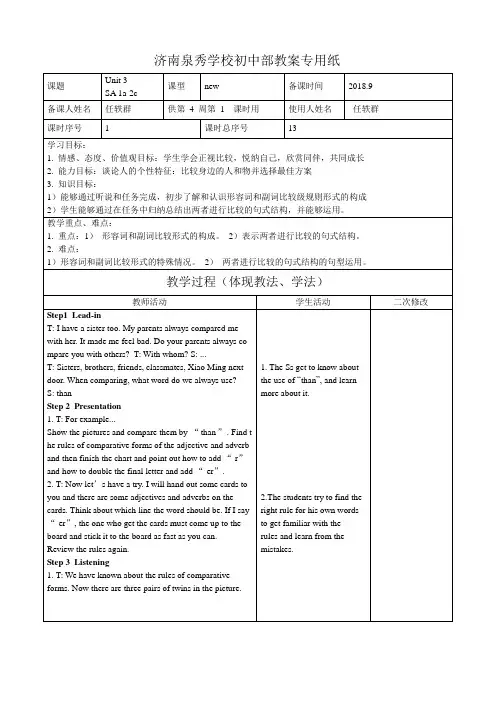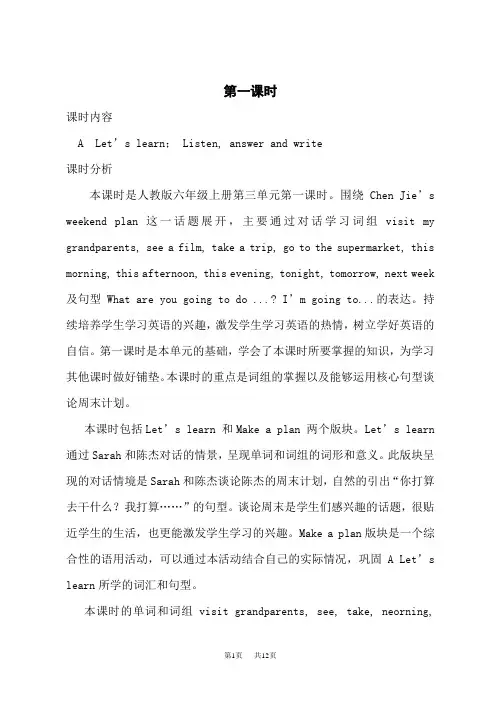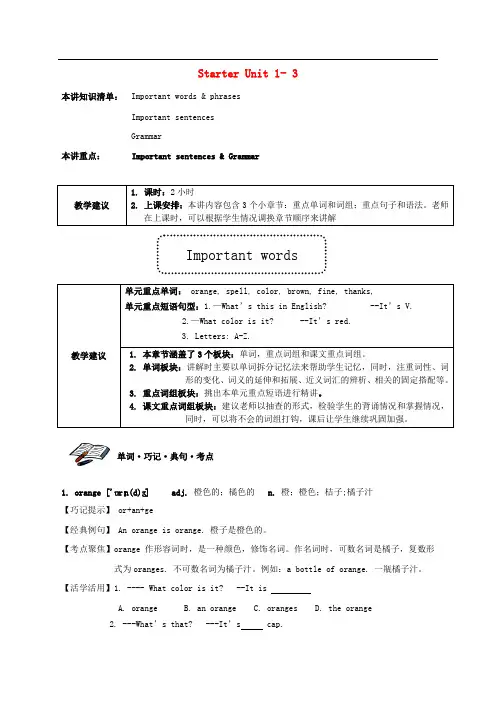Unit 3--1 教案纸
八年级上 英语 人教版 Unit 3 精品 教案(无反思)

1.T: So we can find the word“than”is everywhere in our life, just like the picture, an old woman to a beautiful lady, bad to good.
2.Introduce the rule of Task 5 by asking and checking. T: Now I say“I’m beautiful.”If you get the hat, what will you say?
T: Sisters, brothers, friends, classmates, Xiao Ming next
door. When comparing, what word do we always use?
S: than
Step 2 Presentation
1. T: For example...
T: What should you do then? T: What should you say?
3. Try to use the word on the screen.
Step 5 Listening
Before listening:
Practice the words on the board in a comparative sentences to conquer the new words.
the differences.
2.Play a cartoon(The cat and the mouse)
Give Ss an example by comparing The cat and the mouse. e.g. The cat is taller than the mouse.
英语三下一单元英文教案

英语三下一单元英文教案Unit 3 Lesson Plan for English Class。
Title: Exploring the World of Animals。
Objective: By the end of the lesson, students will be able to identify and describe different types of animals, their habitats, and their characteristics.Materials: 。
Pictures of different animals。
Worksheet with questions about animals。
Whiteboard and markers。
Animal sound recordings。
Introduction (10 minutes)。
Greet the students and ask them to sit in a circle.Show the students pictures of different animals and ask them to identify each animal.Discuss with the students what animals they know and where they live.Activity 1: Animal Sounds (15 minutes)。
Play recordings of different animal sounds and ask the students to guess which animal is making the sound.Discuss with the students the different sounds that animals make and why they make those sounds.Activity 2: Animal Characteristics (20 minutes)。
Unit3Lookatthiselephant(教案)湘少版英语四年级上册

分层作业(书面作业)
实践型作业
听说读、体育锻炼、劳动
时
作
基本部分
选做部分 实践、科技创新、艺术欣
长
赏、其它 业
布
5
置
创作动物形象并描述
表演课本
2
内容
0
分
钟
板书 设计
S3: It’s grey.
学生通过思考 Anne 说了什么话,能在真 实情境中使用适当 语言。
学生通过活动 1 能立 刻联系实际,想到可 以在真实情境中表达 的内容。激活已知,运 用已知。
② monkey
T: Let's go on(. 播放第二段 视频)
T: What fruit does the monkey
多更难的形容词汇描述动T物:,Le促t's 进go语on.言的内化,从学习理解过渡到应用实 践。
通过利用信息化技 术查找资料,了解
Look at that tiger. It’s strong. 学 习 运 用 现 代 化 技 (复述 Lingling 的话,在 术,解决实际问题。在
更多动物的信息
Anne 和 Minging 头上出示 真实情境中迁移创新
目 2.通过借助信息技术,分组利用平板观察形态特别的动物,马来貘、鸭嘴
标 兽、火烈鸟、河狸等,在真实的语境中了解动物世界的奇妙,拓展视野,
发散思维,激发对动物的探索欲望。
Hale Waihona Puke 教学 重点3.课后能同伴互助,进行小组合作,想象、设计出不同且富有创意的动物形 1象. 运,用并所用学英词语汇进句行型描谈述论,动迁物移创新运用所学知识。
在看、听、说的活 动中获取、梳理本 节课的重点词句
(学习理解)
人教PEP版小学六年级上册英语Unit3 My weekend plan 教案 第1课时

第一课时课时内容A Let’s learn; Listen, answer and write课时分析本课时是人教版六年级上册第三单元第一课时。
围绕Chen J ie’s weekend plan这一话题展开,主要通过对话学习词组visit my grandparents, see a film, take a trip, go to the supermarket, this morning, this afternoon, this evening, tonight, tomorrow, next week 及句型What are you going to do ...? I’m going to...的表达。
持续培养学生学习英语的兴趣,激发学生学习英语的热情,树立学好英语的自信。
第一课时是本单元的基础,学会了本课时所要掌握的知识,为学习其他课时做好铺垫。
本课时的重点是词组的掌握以及能够运用核心句型谈论周末计划。
本课时包括Let’s learn 和Make a plan 两个版块。
Let’s learn 通过Sarah和陈杰对话的情景,呈现单词和词组的词形和意义。
此版块呈现的对话情境是Sarah和陈杰谈论陈杰的周末计划,自然的引出“你打算去干什么?我打算……”的句型。
谈论周末是学生们感兴趣的话题,很贴近学生的生活,也更能激发学生学习的兴趣。
Make a plan版块是一个综合性的语用活动,可以通过本活动结合自己的实际情况,巩固 A Let’s learn所学的词汇和句型。
本课时的单词和词组visit grandparents, see, take, neorning,afternoon, evening, tomorrow,虽然没有集中涉及过,但是学生曾经学生,有一定的基础。
在设计教学过程时,先用游戏、简笔画猜一猜的活动激活旧知,然后结合教材设置的情境学习新知,运用听、说、读、写、玩等多种教学手段帮助学生理解和巩固所学新知,全面调动学生的积极参与,让学生在快乐的氛围中学会知识。
人教版新目标版七年级英语上册 Starter Unit 1-3复习教案

Starter Unit 1- 3 本讲知识清单:Important words & phrasesImportant sentencesGrammar本讲重点: Important sentences & Grammar教学建议1. 课时:2小时2. 上课安排:本讲内容包含3个小章节:重点单词和词组;重点句子和语法。
老师在上课时,可以根据学生情况调换章节顺序来讲解教学建议单元重点单词: orange, spell, color, brown, fine, thanks,单元重点短语句型:1.—What’s this in English? --It’s V.2.—What color is it? --It’s red.3. Letters: A-Z.1. 本章节涵盖了3个板块:单词,重点词组和课文重点词组。
2. 单词板块:讲解时主要以单词拆分记忆法来帮助学生记忆,同时,注重词性、词形的变化、词义的延伸和拓展、近义词汇的辨析、相关的固定搭配等。
3. 重点词组板块:挑出本单元重点短语进行精讲。
4. 课文重点词组板块:建议老师以抽查的形式,检验学生的背诵情况和掌握情况,同时,可以将不会的词组打钩,课后让学生继续巩固加强。
单词·巧记·典句·考点1. orange['ɒrɪn(d)ʒ] adj. 橙色的;橘色的 n. 橙;橙色;桔子;橘子汁【巧记提示】 or+an+ge【经典例句】 An orange is orange. 橙子是橙色的。
【考点聚焦】orange 作形容词时,是一种颜色,修饰名词。
作名词时,可数名词是橘子,复数形式为oranges. 不可数名词为橘子汁。
例如:a bottle of orange. 一瓶橘子汁。
【活学活用】1. ---- What color is it? --It isA. orangeB. an orangeC. orangesD. the orange2. ---What’s that? ---It’s cap.Important wordsA. orangeB. an orangeC. a orangeD. the orangeKey: 1. A; 2. B2. spell [spel] vt. 拼,拼写;【经典例句】 spell it ,please. 请拼写它。
实用英语综合教程1_unit3

Unit 3 Gifts
Warm-up Listening and Speaking Text A Grammar Tips Text B Comprehensive Exercises Practical Reading and Writing
《实用综合教程(第二版)》第1册电子教案
Unit 3 Gifts
实用综合教程第二版第1册电子教案对某物或某事要适度bemodestwith葡萄酒winen
Unit 3 Gifts
Objectives In this unit, you will — get to know the rules of gift giving; — learn how to say and receive thanks;
《实用综合教程(第二版)》第1册电子教案
Unit 3 Gifts
Background Information
Discussion
Question 1: All of us must have sent gifts to or received them from our friends, family members, relatives, etc. What is the most memorable gift you have sent or received?
《实用综合教程(第二版)》第1册电子教案
Unit 3 Gifts
Background Information
Discussion
When to give gifts? In China the occasions requiring gifts and presents mainly include friends’ birthday parties, wedding ceremonies, baby showers, and visiting old people, especially during festivals, or visiting sick friends or relatives. Westerners may give gifts on any occasion, and the following situations are where gifts and presents are necessary: weddings, Christmas, birthdays, wedding anniversaries, house-warming parties, baby showers, graduation, etc.
(部编)人教版(PEP)四年级英语上册Unit3单元教案1
Unit 3 My friends第一课时一、教学内容Part A Let’s talk & Let’s play二、教学目标1. 能听懂、会说句型:What’s his name? His name is... He’s......2. 能听、说、认读句型:I have a new friend. A Chinese friend? What’s his name? His name is三、教学重难点1. 掌握单词Chinese, friendly的发音和书写。
2. 能在情境中正确运用本课时的对话询问他人的信息。
四、教学准备1. 录音机、磁带、教学课件、单词卡。
2. 几张班里学生的生活照照片,John和他妈妈的图片。
五、教学过程Step 1 Warming-up1.师生问答练习。
T: Who’s your best friend?S: …2.教师先自我介绍My name’s ...,然后提问一名男生What’s your name?该名学生回答问题后,教师对大家说:His name is... He is... 教师问学生:What’s his name? 启发学生回答:Hisname is...教师继续指其他男生,重复该句型的练习。
Step 2 Presentation1.学习Let’s talk... ”(1)教师出示课文人物图片,让学生做问答:“What’s his/her name?”“His/Her name is(2)出示班里某个学生的照片,教师说:“Look, I have some pictures.Look at this picture, whocan tell me his /her name? ”“His/Her name is…” (3)教师依次出示一些学生的照片,让学生看着照片运用所学知识对这个学生进行描述。
例如:His name is Peter. He has short black hair and big eyes.(4)教师出示John的图片问:What’s his name? 学生回答John.教师再出示他妈妈的图片,说:“She is John’s mother. John is talking about his Chinese friend to his mother”.教学Chinese.教师: “We are all Chinese, because we are all from China.”(5)让学生带着问题听录音。
新译林版英语四年级上册第三单元教案
1. Greeting
2. Free talk:抛绣球
【设计意图】练习使用“What do you like?”“I like…”以及一些学过的句型(Do you like/have…?)改变以往的Free talk比较枯燥的模式,通过这个游戏让学生争着说英语,爱上说英语,减轻学生学习英语的思想负担,在游戏中进行对话练习,激起学生的学习兴趣。例如:
1. Story time导入
T: Hey, look. What’s this in English?
S: It’s a toy car.
T: Do you like this toy car?
S: Yes, I do./No, I don’t.
T: Here are many toy cars. How many toy cars?
Q2: How many stickers does Helen have?
T:Are you right?同法学习How many toy cars/ stickers do you have?
5. Read and try to match
【设计意图】让学生分成小组一起阅读课文,完成连线的练习题。培养学生的团结合作能力。让成绩好的学生帮助后进生,防止后进生在这个环节中懒得思考等答案。
I’m I have
Mikefifteen nice stickers
Helenthirteen beautiful toy cars
完整的句子:
I’m Mike. I have thirteen nice toy cars.
I’m Helen. I have fifteen beautiful stickers.
牛津沪教版英语四年级上Unit 3 Are you happy 教案(公开课)2
Module 1 Unit 3 教案2一、教学重点句型:I’m happy.Are you thirsty, Ben?日常用语:Thanks二、教学栏目Listen and say, Play a game三、教学目标1. 通过Listen and say对话,帮助学生学习句型Are you ...(adj.)?及其答复。
2. 通过Play a game猜谜游戏,帮助学生进一步稳固和运用句型Are you ...?四、教学步骤Pre-task preparations1.出示表示各种感觉的单词卡片,如thirsty,happy,sad,full,hungry,请学生看图说出人物的感觉,复习表示感觉的单词。
接着,教师再说各种情景,要求学生根据情景快速接龙,注意学生接的句子要和前一句有关联。
T: You have a new bicycle.S1: I have a new bicycle. I’m happy.T: I want some water.S2: You want some water. You are thirsty.或给出情景,让学生答复以下问题。
T:〔show a picture of a new bag)You have a new bag. Are you happy?S: Yes. I have a new bag. I’m happy.2.学生根据教师的指令做Quick response活动,教师一边发指令一边和学生一起做动作。
T: Run, run, run very fast. Jump, jump, jump high. Swim, swim, swim very well. Climb, climb,climb trees.Ss: (do the actions)学生跟着教师做好动作后,教师说I’m tired. Are you tired?,然后把句型写在黑板上。
外研版(一起)三年级英语下册《Module 3 Unit 1》教案设计2
外研版(一起)三年级英语下册《Module 3 Unit 1》教案设计2教学目标1.通过学习本课,使学生能够掌握颜色词汇的表达;2.通过本节课的教育训练,让学生能使用语言表达自己对于一些简单的、有趣的表达要求;3.教育学生要进一步发扬团队合作的精神与意识,提高学生的合作精神与能力。
教学重、难点1.教学重点:使学生掌握颜色词汇的表达;2.教学难点:如何可以培养学生的口语交流能力以及合作精神与意识。
教学准备1.课文;2.多媒体投影设备;3.教学用具:颜色卡片,颜色笔。
教学过程导入1.导入与颜色有关的话题。
老师提问:Do you know any colors in English?可以带入一些例子,如:What color is your pen?What color is the sky today?2.让学生完成“找同桌”的活动。
告知学生任务,学生在桌上互相交换小礼物,然后请同桌用英文表达自己礼物的颜色,时间2分钟。
老师引导同学回答。
学习学生学习颜色词汇将颜色卡片从用具袋内取出。
对于每个颜色,老师表演相应的动作和表情,并说出颜色,要求学生观察老师和卡片,跟读颜色。
不太明白的再反复提问。
合作练习1.学生找一组,在教室内找出6个纯色的物品;2.在纸上画出一个6x6的方格,将颜色填充到其中,每个颜色占用不多于2个格子;3.看看有多少个颜色,如果不够10种,可以再添加,最终讨论,并找出英文,尝试翻译成自己的语句;4.每一组找出一个代表”小组颜色表“的同学,另一边的同学是要询问别的小组的颜色种类和具体颜色所在的位置的提问者,请完成这个活动。
5.结束后老师会随机点名学生,让他们向全班汇报。
评价1.在教室墙壁上贴上一个颜色方块,让学生把不同颜色的小纸条粘贴到相应的颜色中。
学生在班级内点击他们的颜色来表示他们在颜色界中的位置。
让同学说出自己的颜色,老师讲解每个学生颜色的英语表述;总结本节课教学重点在于使学生理解曼彻斯特街流行的简化版,帮助学生领会较新的口语交流的技术。
- 1、下载文档前请自行甄别文档内容的完整性,平台不提供额外的编辑、内容补充、找答案等附加服务。
- 2、"仅部分预览"的文档,不可在线预览部分如存在完整性等问题,可反馈申请退款(可完整预览的文档不适用该条件!)。
- 3、如文档侵犯您的权益,请联系客服反馈,我们会尽快为您处理(人工客服工作时间:9:00-18:30)。
Unit 3 Listening & SpeakingTeaching Procedure:I.Greetings and leading in.1.Today we’ll take up a new unit, Unit 3. In this unit, you’lllearn to ask questions to know customers’ need, understand the important role of a server and use up-selling techniques.II.Warm-up1.Activity 1: Some people are talking about the service they’vereceived. Have they received good or bad service? Write G for good or B for bad in the blanks.1)Discussion.2)Judge if the service is good or bad.3)Exchange their ideas.2.Activity 2: Discuss in groups: What should be done improvethe bad service mentioned above.3.Some points:1) The waiter was talking on the phone while taking my order.服务员一边给我点单一边打电话。
# on the phonee.g. You are wanted on the phone.# take one’s order 为……提供点菜服务。
e.g. May I take the order for you now? 现在可以为您点菜了吗?2) I asked a clerk for help and got an eye roll and big sigh as response.我请一名店员帮忙,得到的答复却是白眼,外加一声长叹。
# ask sb. for sth. 向某人要某物e.g. I asked him for help when I was in trouble.We can’t always ask our parents for money.# eye roll 眼球转动get an eye roll 被翻白眼# sigh [sai] n.叹息(声) vi.叹息,叹气big sigh 长叹3) The store clerk told me about a coupon that helped me save a lot.销售员告诉我可以使用优惠券,帮我省了不少钱。
# coupon n.礼券,优惠券# save a lot 节省很多…e.g. Here is a coupon for today’s bread.This coupon may save a lot for me.III.L istening and SpeakingA.Checking In1.New words and expressions.1) attend v. 照顾2) check in 登记住店R: check out3) clerk n. 旅馆服务台接待员;职员4) reservation n. 预订reserve v.5) correct adj. 正确的6) upper adj. 较高的7) away from 远离8) fill v. 填写fill in / out9) registration n. 登记10) form n. 表格fill out the registration form11) further adj. 更多的; 更远的;进一步的e.g. I will go abroad for further study.12) front desk 前台,总台13) assistance n. 帮助14) manage v. 能解决(问题);应付(困难局面等)2.Activity 1: Listen to the conversation and tick where ithappens.1). First show Ss three pictures and judge where theyshow.2). Listen to the CD and tick where it happens.3). Check up.3.Activity 2: Listen again. Then underline the questions askedby the hotel clerk..1). Ss listen to the tape and underline the questions.2). Check up.Clerk: Welcome to the Sheraton. May I help you?Guest: I’d like to check in. I have a reservation.Clerk: What’s your name, please?Guest: Phillip Parker.Clerk: Yes, Mr. Parker. You required a single room for three nights, is that correct?Guest: Yes, could I have a room on the upper floors, away from the street?Clerk: No problem. Could you fill out the registration form, please?Thank you. And will you be paying by cash or credit card?Guest: Cash, if you accept American dollars.Clerk: Of course, sir. Your room number is 1109. Here is your key.Enjoy your stay at the Sheraton. If you require anythingfurther, feel free to call the front desk. Would you likeassistance with your bags?Guest: No thanks, I only have one. I can manage.3). Read the dialogue.4). Act out the dialogue.5). Useful expressions.6). Some language points.1) I’d like to check in. I have a reservation.我要登记入住。
我预订过。
# check in 意为“登记入住”,check out 意为“结账离店”。
# have a reservation 意为“有预订”。
e.g. He has just checked in at the hotel.I’ll be checking out on Friday.2) You requested a single room for three nights, is that correct?您需要一间单人间住三晚,对吗?# a single room 意为“单人间”,a double room 意为“双人间”。
3) Could I have a room on the upper floors?我可以要一间位于较高楼层的房间吗?# on the upper floors 意为“在上面一点的楼层”,on the lower floor 在下面一点的楼层4) Could you fill out the registration form, please?# 您可以填一下这张登记表吗?# could you…? 意为“你能…吗?”委婉的语气,用在接待顾客中,比较正式而又礼貌# fill out the registration form 填写登记表fill out / in 意为“填写(表格)”。
e.g. Please fill out / in the application form.be filled with / be full of 充满e.g. The bottle was filled with / full of milk.The news filled her with hope.5) pay by cash or credit card# cash 意为“现金”,credit card信用卡,按发卡组织分:Visa 维萨卡MasterCard万事达卡、American Express美国运通卡、UnionPay银联卡等6) Enjoy your stay at the Sheraton. 祝您在谢尔顿酒店住的愉快!# stay 意为“停留、逗留”,住在酒店,不用live, 而用stay.e.g. How many nights will you be staying?7) feel free to 意为“请随意……”8) I can manage. 我能处理好。
# manage 意为“办理;设法对付”e.g. Can you manage it?Mr. White manages a large department store.manage to do sth. Compare: try to do sth.e.g. I managed to get there on time.He managed to finish the task at last.4.Activity 3: Suppose you work at the front desk of a hotel.Ask proper questions to get the following information.①name of the guestQuestion: What’s your name, please? / May I have your name,please?②kind of room neededQuestion: Do you prefer a smoking or non-smoking room? / Whatkind of room would you like, a single or a double? /Would you prefer a single or double?③number of guestsQuestion: How many of you?④length of stayQuestion: How long will you be staying?5.Activity 4: Complete the conversation and then role-play itwith your partner.Front Desk: Welcome to the Home Inn. How may I help you?Guest: I’d like a room, please.Front Desk: Single or double?Guest: A double, please. How much is that?Front Desk: It’s $ 145.00 a night. How long will you stay?Guest: Just tonight.Front Desk: OK. One night comes to $ 145.00 plus tax. May I haveyour name?Guest: It’s Davies. Robert Davies.Front Desk: How to spell?Guest: It’s D-A-V-I-E-S.# come to 意为“总计为”。
